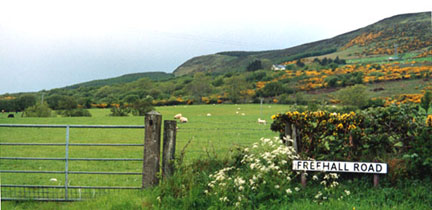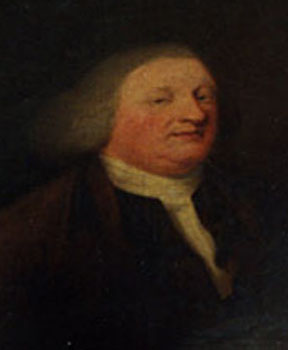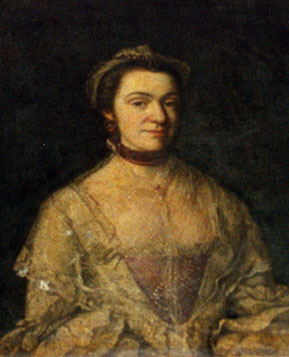THE HILLHOUSE FAMILY
LONDONDERRY
Northern Ireland
An American found tracing family
roots can seem a peculiar oddity to people in the countries from
where our ancestors immigrated. After all, many centuries of
family lineage are still firmly grounded on the land of their
ancestors. It may come as a comfort to those who stayed to know
that once driven from those well-loved landscapes by persecution
or famine, early immigrants landed in 18th and 19th Century America
looking for the lay of familiar land. They named their parishes
and towns in memory of the life they left behind, names like
Derry and Londonderry, New Hampshire or hundreds of other place
names brought from Britain, Europe and nearly all of the countries
of the Earth. They brought their traditions and their passion
in search of a chance to start a new life. The ties remain true
whether spoken or silenced to just beneath the surface, ready
to reveal itself again through the backward glance of the generations
of descendants that follow.
According to Margaret P. Hillhouse's "Historical and Genealogical
Collections Relating to the Descendants of Rev. James Hillhouse"
(1924) Abraham Hillhouse of Artikelly, Ireland was born sometime
before 1639 when he moved from Ayrshire, Scotland to Ireland
as a landholder in the Ulster Plantation. The family resided
in the Parish of Aghanloo for most of their 120 year stay in
Northern Ireland, the townlands where their name appears in historical
records include Ballycastle, Artikelly, Free Hall, Streeve Hill
and at least 101 days held in siege in 1689 of the city of Derry.
Reid's History - 1644 quote "Abraham Hillhouse, of Ballycastle
and a burgess of Limavady with a large number of people took
the Oath of the Covenant in September 1644 at Ballycastle, and
there met the Scottish Ministers on their return from Londonderry
to Coleraine."
Abraham (1) and Janet Hillhouse had
three children, Abraham (2), James (1) and John (1). His will
is dated 1676 states he was "to be buried in such charges
as my dear wife, Janet, and my eldest son, Abraham Hillhouse,
shall think fit." Free Hall is first mentioned in the 1667
and was the birthplace that year of their son John.

Located two miles west
of Limavady off the Coleraine Road is what I believe is the land
where the fortified manor house of Freehall once graced. On a
landing just down the hill from the white house in the distance,
is a secluded farmstead. The barnyard and new house are nestled
among the ruins of the old house and grounds, now reduced to
the remains of the stone corner wall of the old fort and clumps
of foundation stone across the driveway
|
Son, Abraham (2) was among the people
who endured the horrors of the Siege of Derry in 1689. He later
married twice, his second wife Anne Ferguson had two children,
-- and Rachel. His brother, James, is said to been the Mayor
of Derry in 1693.
Brother John and his wife Rachel inherited the Free Hall estate
and raised six sons, Abraham (3), James (2), William, John (3),
Samuel and Charles. Taken from Abraham (3) Hillhouse's family
bible - "My mother, Rachel Hillhouse died January 7, 1716
and is buried in our burial place in the church of Arclow. My
father, John Hillhouse died Tuesday, July 31, 1716 and was buried
in the church of Arclow (old Church
of Aghanloo)."

The Aghanloo New Church
was built in 1826 from the ruins of the Old
Church Aghanloo (Arclow) just a few hundred feet down the
road. The Old Church cemetery can be found at a curve in the
road, however the grave stones of the John and Rachel Hillhouse
buried there in 1716 have vanished. Many gravestones before the
1800s were made of sandstone, weather and time have wiped them
clean. Benevenagh Mountain frames the scene in the distance.
|
Abraham's daughter Rachel would inherit
Freehall after her father's death in 1756. Upon her death a few
years later, the Hillhouse lands were absorbed into the McCausland
estate. Rachel was married to Frederick McCausland. The McCauslands,
a distinguished family of Scottish origins, have flurished through
the centuries on the townland of Streeve Hill, which he bought
in 1741 and Fruit Hill, his brothers adacent land now known as
the Drenagh
Estate.
 |

|
The portraits of Frederick
& Rachel McCausland (criteria 1750) still grace the main
floor galleries of Drenagh Estate.
|

ACKNOWLEDGMENTS
I am most indebted to a German
resident of that town, Jochen Lueg, who has an extensive website
covering Limavady
and the Roe Valley. The Hillhouse name and the fortified
manor house, Free Hall, as I would come to discover, has all
but disappeared from existence in Londonderry. Jochen did find
the directions to the property very familiar and tied it with
McCausland property nearby. It was a short search connecting
the names of Hillhouse and McCausland to link the two families
by marriage in 1741. In the months before my visit, Jochen was
very kind to research what he could on his end and I was able
to give him many clues to pursue.
My next connection was with the gracious owners of Streeve Hill
B&B, Peter and June Welsh. Streeve Hill was Frederick &
Rachel (Hillhouse) McCausland's family home from 1741-1765. The
Welshes went well out of their way to provide for my comfort
and desire to know more about the Hillhouse family and where
they had lived.
I am also most indebted to Frank the owner of Bells Taxis as
my local driver and guide who shared his love of the history
of the city of Derry and county of Londonderry and waded through
the neetles of the local cemeteries to help me in my research.
I also must thank Ian Campbell and his wife who reside at Ballycastle
and spent a morning with me sharing the printed history of the
area in their possession. It was there that the mystery of the
location of the graveyard at the Church of Arclow was revealed.
Jan
Eloise Morris
2007